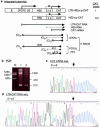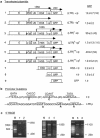The ERV-9 LTR enhancer is not blocked by the HS5 insulator and synthesizes through the HS5 site non-coding, long RNAs that regulate LTR enhancer function
- PMID: 12888519
- PMCID: PMC169934
- DOI: 10.1093/nar/gkg646
The ERV-9 LTR enhancer is not blocked by the HS5 insulator and synthesizes through the HS5 site non-coding, long RNAs that regulate LTR enhancer function
Abstract
A solitary long terminal repeat (LTR) of ERV-9 human endogenous retrovirus is located upstream of the HS5 site in the human beta-globin locus control region and possesses unique enhancer activity in erythroid K562 cells. In cells transfected with plasmid LTR-HS5-epsilonp-GFP, the LTR enhancer activates the GFP reporter gene and is not blocked by the interposed HS5 site, which has been reported to have insulator function. The LTR enhancer initiates synthesis of long RNAs from the LTR promoter through the intervening HS5 site into the epsilon-globin promoter and the GFP gene. Synthesis of the sense, long LTR RNAs is correlated with high level synthesis of GFP mRNA from the epsilon-globin promoter. Mutations of the LTR promoter and/or the epsilon-globin promoter show that (i) the LTR enhancer can autonomously initiate synthesis of LTR RNAs independent of the promoters and (ii) the LTR RNAs are not processed into GFP mRNA or translated into GFP. However, reversing the orientation of the LTR in plasmid (LTR)rev-HS5-epsilonp-GFP, thus reversing the direction of synthesis of LTR RNAs in the antisense direction away from the epsilon-globin promoter and GFP gene drastically reduces the level of GFP mRNA and thus LTR enhancer function. The results suggest that the LTR-assembled transcription machinery in synthesizing non-coding, LTR RNAs can reach the downstream epsilon-globin promoter to activate transcription of the GFP gene.
Figures








Similar articles
-
The long terminal repeat (LTR) of ERV-9 human endogenous retrovirus binds to NF-Y in the assembly of an active LTR enhancer complex NF-Y/MZF1/GATA-2.J Biol Chem. 2005 Oct 21;280(42):35184-94. doi: 10.1074/jbc.M508138200. Epub 2005 Aug 16. J Biol Chem. 2005. PMID: 16105833
-
The LTR enhancer of ERV-9 human endogenous retrovirus is active in oocytes and progenitor cells in transgenic zebrafish and humans.Proc Natl Acad Sci U S A. 2004 Jan 20;101(3):805-10. doi: 10.1073/pnas.0307698100. Epub 2004 Jan 12. Proc Natl Acad Sci U S A. 2004. PMID: 14718667 Free PMC article.
-
The solitary long terminal repeats of ERV-9 endogenous retrovirus are conserved during primate evolution and possess enhancer activities in embryonic and hematopoietic cells.J Virol. 2002 Mar;76(5):2410-23. doi: 10.1128/jvi.76.5.2410-2423.2002. J Virol. 2002. PMID: 11836419 Free PMC article.
-
Utility of next-generation RNA-sequencing in identifying chimeric transcription involving human endogenous retroviruses.APMIS. 2016 Jan-Feb;124(1-2):127-39. doi: 10.1111/apm.12477. APMIS. 2016. PMID: 26818267 Review.
-
Distant sequences which regulate globin genes.Prog Clin Biol Res. 1985;191:29-48. Prog Clin Biol Res. 1985. PMID: 2996023 Review.
Cited by
-
Genes associated with the cis-regulatory functions of intragenic LINE-1 elements.BMC Genomics. 2013 Mar 27;14:205. doi: 10.1186/1471-2164-14-205. BMC Genomics. 2013. PMID: 23530910 Free PMC article.
-
A facilitated tracking and transcription mechanism of long-range enhancer function.Nucleic Acids Res. 2007;35(16):5532-44. doi: 10.1093/nar/gkm595. Epub 2007 Aug 17. Nucleic Acids Res. 2007. PMID: 17704132 Free PMC article.
-
Inactive X chromosome-specific histone H3 modifications and CpG hypomethylation flank a chromatin boundary between an X-inactivated and an escape gene.Nucleic Acids Res. 2009 Dec;37(22):7416-28. doi: 10.1093/nar/gkp860. Nucleic Acids Res. 2009. PMID: 19843608 Free PMC article.
-
To ERV Is Human: A Phenotype-Wide Scan Linking Polymorphic Human Endogenous Retrovirus-K Insertions to Complex Phenotypes.Front Genet. 2018 Aug 14;9:298. doi: 10.3389/fgene.2018.00298. eCollection 2018. Front Genet. 2018. PMID: 30154825 Free PMC article.
-
New bioinformatic tool for quick identification of functionally relevant endogenous retroviral inserts in human genome.Cell Cycle. 2015;14(9):1476-84. doi: 10.1080/15384101.2015.1022696. Cell Cycle. 2015. PMID: 25853282 Free PMC article.
References
-
- Wilkison D., Mager,D. and Leong,J. (1994) Endogenous human retroviruses. In Levy,J. (ed.), The Retroviridae. Plenum Press, New York, NY, Vol. 3, pp. 465–535.
-
- Smit A.F. (1996) The origin of interspersed repeats in the human genome. Curr. Opin. Genet. Dev., 6, 743–748. - PubMed
-
- Henikoff S., Greene,E., Pietrokovski,S., Bork,P., Attwood,T. and Hood,L. (1997) Gene families: the taxonomy of protein paralogs and chimeras. Science, 278, 609–614. - PubMed
-
- Temin H.M. (1981) Structure, variation and synthesis of retrovirus long terminal repeat. Cell, 27, 1–3. - PubMed
Publication types
MeSH terms
Substances
Associated data
- Actions
Grants and funding
LinkOut - more resources
Full Text Sources
Other Literature Sources

